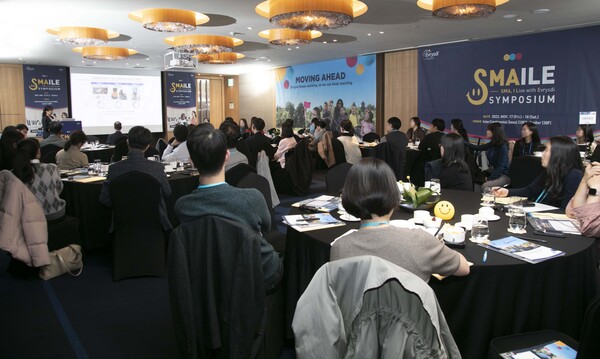
The first oral drug for spinal muscular atrophy (SMA), Evrysdi (risdiplam), has produced encouraging results in various patient groups by exposing the drug more systemically to the entire body.
Dr. Reiko Arakawa, a professor in the Department of Genomics at the National Center for Global Health and Medicine (NCGM) in Japan, explained this at the “SMAILE (SMA I Live with Evrysdi),” a symposium held by Roche Korea to commemorate the launch of Evrysdi in Korea, on Friday and Saturday.
Evrysdi has won approval in 100 countries and is used by 11,000 patients worldwide. It was approved in Korea in November 2020 and has received insurance benefits since last month.
"Evrysdi is the first small molecule splicing modulator that, when taken orally, reaches the patient from head to toe and uniformly increases the concentration of survival motor neuron (SMN) protein throughout the body," Dr. Arakawa said. "SMA is a systemic disease characterized by a decrease in SMN protein in cells throughout the body, which affects the function of various body organs other than neuromuscular and the digestive tract. It is a systemic disease that affects the function of various organs, the digestive tract, and blood vessels other than the neuromuscular system. The administration of Evrysdi enables more systemic drug exposure to the whole body, effectively improving patients' whole-body functions, such as swallowing, sitting, and walking."
Dr. Arakawa said that Japan is one of the countries with the largest number of SMA patients using Evrysdi and is accumulating experience with a wide range of patient populations, including ultra-treatment patients and patients who have switched from other disease-modifying drugs.
"We are seeing encouraging results in a wide range of patient populations in real-world practice, and we look forward to gaining meaningful treatment experience in Korea in the future," she added.
According to a presentation by Professor Cho Anna of the Department of Pediatrics at Seoul National University Bundang Hospital, Evrysdi has confirmed its efficacy and safety profile in multiple global clinical studies (FIREFISH, SUNFISH, JEWELFISH, RAINBOWFISH) across a wide range of age groups and SMA types, from infants to adolescent adults, including pre-symptomatic patients. The safety profile and tolerability have also been confirmed in patients on other existing disease-modifying therapies.
"The recent paradigm shift in the treatment of SMA, including the introduction of oral agents, such as Evrysdi, will allow for more personalized treatment based on patient age and stage," Professor Cho said. "As Evrysdi has shown significant efficacy and safety profiles in long-term data from clinical studies, we expect a broader patient population to benefit from oral therapy in the future."
Professor Park Hyung-jun of the Department of Neurology at Gangnam Severance Hospital presented his experiences using Evrysdi on Korean SMA patients.
"Evrysdi can effectively improve muscle weakness in SMA patients, and it has the advantage of being orally administered once daily, making it easier for patients to take and manage their disease," Park said. "However, as the reimbursement standards limit prescription to a maximum of two bottles at a time, it remains to be seen how these variables will affect future treatment, and it may be necessary to improve the standards."
Under the current reimbursement guidelines, motor function is assessed using an instrument that considers the patient's age and condition. Suppose the age at the time of administration is 24 months or younger. In that case, CHOP-INTEND (neuromuscular disease test) is used as the primary assessment tool (required), and HINE-2 (Hammersmith Infant Neurological Examination) is used as a secondary assessment tool. Suppose the child is over 24 months old. In that case, HFMSE (Hammersmith Functional Motor Expansion Index) is used as the main evaluation tool, and RULM (revised upper limb module), CHOP-INTEND (non-sitter, up to age 5), and CHOP-ATEND (non-sitter) are used as auxiliary evaluation tools.
"Objective tools have been newly reflected in the criteria so that SMA patients can be evaluated across functional categories," said Professor Kim Soo-yeon of the Department of Rehabilitation at Pusan National University Yangsan Hospital. "It is expected that we can achieve better treatment through more precise evaluation as we can use more detailed evaluation indicators to evaluate patients' motor function.”

